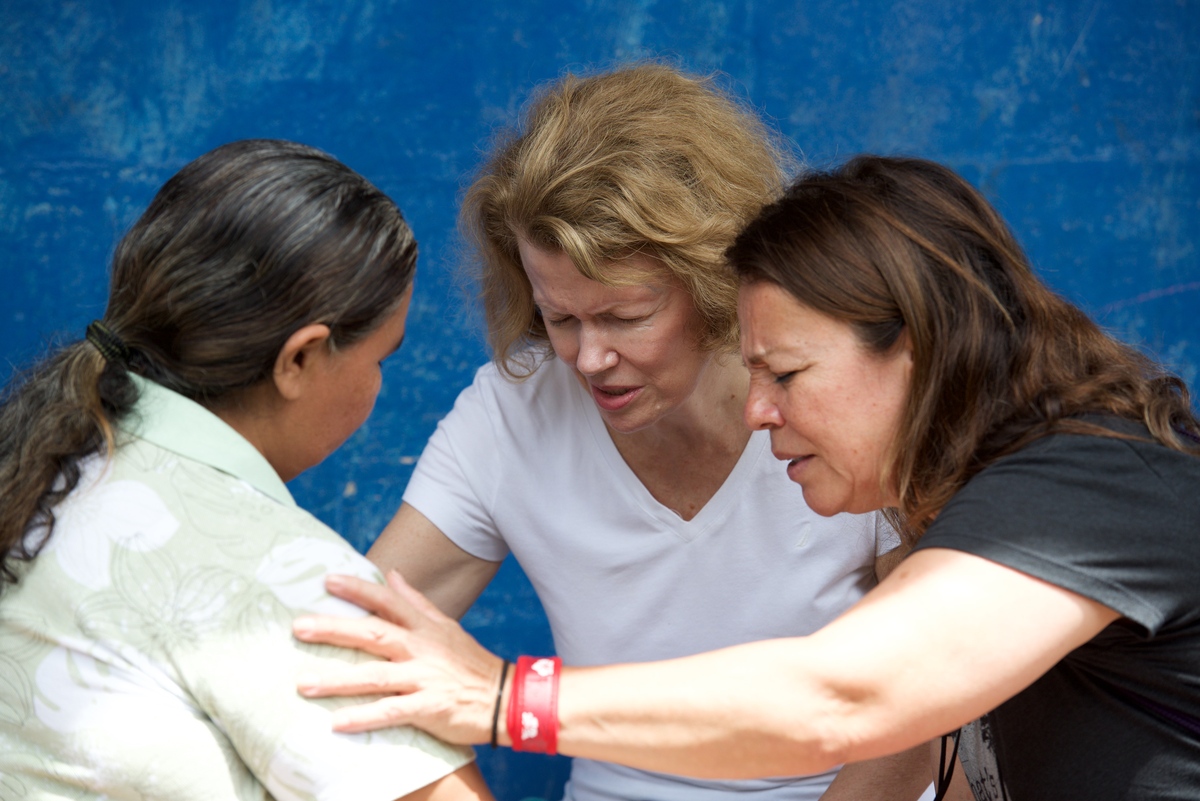La narrativa y el Evangelio: el aprendizaje oral en el Perú
América Latina¿Quién te lo contó?
Piensa en una de las primeras cosas que aprendiste de niño. ¿Cómo la aprendiste? ¿Te la contaron tus padres? ¿La escuchaste en la televisión o en clase?
Piensa en la primera vez que oíste hablar de Jesús. ¿Te lo contó un pastor? ¿Te lo contó un amigo?
Es muy probable que lo primero que aprendiste de niño, y la primera vez que conociste a Jesús, lo hayas aprendido oralmente . Antes de aprender a leer, aprendemos escuchando. Las primeras historias que escuchamos influyeron en nuestra visión del mundo, de nosotros mismos y de Dios.
Trabajando en las selvas remotas del Perú, donde los libros y las traducciones de la Biblia son escasas, trabajadores globales de AGWM están utilizando el aprendizaje oral (a veces llamado oralidad) para capacitar pastores, discipular creyentes y establecer la Iglesia.
Discipulado autóctono
En la densa selva tropical del este de Perú, la comunicación entre las iglesias es limitada. Steve Ford, misionero educador de AGWM, vive en Iquitos, Perú, desde hace más de 30 años. Iquitos es la capital de Loreto, un estado del noreste de Perú. Steve viaja en barco para llegar a las comunidades indígenas. «Muchos grupos indígenas se aíslan; viven en lugares recónditos», dice Ford.
Mike y Sonja Trei son trabajadores globales de AGWM que también viven en Iquitos. Mike dice: «La tarea de llegar a los numerosos grupos indígenas es inmensa. El gobierno peruano dice que hay 32 grupos indígenas diferentes en Loreto. Loreto es similar en tamaño a Montana, pero viajamos por sistemas fluviales».
El aislamiento y las diferentes lenguas suponen un reto para trabajadores y pastores. Predomina el animismo, la adoración a los seres espirituales de la naturaleza. Los pastores se encuentran a menudo con personas que mezclan creencias cristianas y animistas.
«En nuestra localidad, la gente ha escuchado el Evangelio durante décadas», dice Mike. «Pero los cimientos no estaban bien puestos. Nos encontramos con muchas malas interpretaciones sobre las verdades bíblicas».
A veces nos encontramos con formas de sincretismo porque las creencias cristianas se pierden en la traducción. «Puede que la gente no tenga una palabra para algo que nosotros damos por sentado», continúa Trei. «Por ejemplo, algunas culturas no tienen una palabra para decir que María era virgen». Los narradores deben trabajar cuidadosamente con los creyentes bilingües para encontrar palabras o descripciones en su lengua cuando no se dispone de una traducción directa.
Esto se complica aún más cuando los trabajadores traducen la Biblia de una cultura escrita a una oral. Muchas lenguas indígenas no tienen una forma escrita. En su lugar, la gente transmite la historia y los conocimientos a través de narraciones.
Mike vivió esta experiencia en un pueblo indígena. "Estaba construyendo una iglesia y a eso de las 3 de la mañana escuché un alboroto. Las voces eran cada vez más fuertes. Entonces alguien encendió un fuego y las voces se hicieron cada vez más fuertes. En estos pueblos, un abuelo se despierta, enciende el fuego y despierta a los demás miembros de la familia. Cuando todos se reúnen, empiezan a contar historias. Así es como transmiten su historia. Eso es el aprendizaje oral».
Formación bíblica oral
Conscientes de la importancia de la narración y el aprendizaje oral para los pueblos indígenas, los misiuoneros de AGWM y la iglesia nacional desarrollaron sistemas de enseñanza oral. Estos sistemas ofrecen a los pastores indígenas la posibilidad de cumplir los requisitos educativos para la ordenación.
Los estudiantes aprenden memorizando y reflexionando sobre historias bíblicas. «Hay 48 conjuntos de historias, o cursos, y cada curso tiene 12 historias», dice Ford. A través de este plan de estudios de varios años, los alumnos escuchan cientos de historias bíblicas del Pentateuco, los Evangelios, los Salmos, etc., e historias que enseñan valores bíblicos y teología. «Hay cursos sobre la familia, cómo manejar el dinero, las parábolas del Reino, la oración, el Espíritu Santo y la naturaleza de Cristo».
Cuando comienza una sesión, el líder recita la historia dos veces. La tercera vez, guía a los alumnos y omite partes de la historia para que los estudiantes las completen de memoria. A continuación, dos o tres alumnos vuelven a contar la historia. Entonces, el animador hace preguntas e inicia un debate.
«Tenemos cinco preguntas básicas», dice Trei. "¿Qué te gusta de la historia? ¿Qué no te gusta? ¿Qué muestra sobre la naturaleza humana? ¿Qué muestra sobre la naturaleza de Dios? ¿Qué te está diciendo Dios en esta historia?». A medida que los alumnos procesan la historia y responden a las preguntas, el líder guía el debate, manteniendo la historia en el centro. Este estilo de enseñanza tiene varias ventajas únicas.
En primer lugar, es más fácil traducir y transmitir historias oralmente, sobre todo si un idioma no tiene forma escrita. «El secreto de contar historias es presentarlas en el idioma del corazón de una persona, su lengua materna», dice Sonja. Sin embargo, con las distintas lenguas esto es difícil.
«Estas lenguas están muy abajo en la lista para llegar a contar con una traducción de la Biblia, y la mayoría tienen un número tan pequeño de hablantes que se consideran insignificantes. No están en el radar de nadie para las traducciones de la Biblia», continúa Sonja. Los traductores bilingües que hablan español y una lengua indígena ayudan a reproducir las historias bíblicas en lenguas indígenas mucho más rápido que lo que tardaría producir una traducción escrita de la Biblia.
En segundo lugar, el aprendizaje oral enriquece la teología bíblica. «Algunos de nuestros alumnos leen y escriben, pero su preferencia es el aprendizaje oral», dice Ford. «La Biblia se sigue traduciendo y leyendo. Sin embargo, después de que algunos estudiantes escuchan la historia, son capaces de leerla y entenderla mejor. Un pastor dijo: “He escuchado a profesores extranjeros, nacionales y de mi propio pueblo. Pero ahora que estamos bajo este sistema oral, por fin entiendo la Biblia”».
La perspectiva única del aprendizaje oral ayuda a todos. «Como docente, a menudo pienso, Bueno, nunca pensé en eso», continua Ford. «Estas perspectivas proceden de aprendices orales, que no por ello son menos inteligentes que un aprendiz tradicional alfabetizado».
En tercer lugar, el estilo de repetición y respuesta del aprendizaje oral involucra a los oyentes en el discipulado. «La participación permite a los oyentes crecer, porque están involucrados», dijo Mike. La inversión personal es clave para un discipulado duradero.
Aunque la formación bíblica oral pueda parecer exótica o única, es un método milenario que incluso Jesús utilizó. «El aprendizaje oral es natural para nosotros», dice Trei. «Es lo que Jesús hacía todos los días cuando contaba historias. Si no estaba contando historias, estaba orando con sus discípulos y formándolos. Esa es la motivación para nosotros».
A la escucha del futuro
A medida que los misioneros de AGWM adoptan técnicas de aprendizaje oral, observan un éxito increíble. En un pueblo, un pastor peruano utilizó la oralidad para revitalizar una iglesia moribunda. «El pastor se sintió llamado a contar historias de la manera que había escuchado», dijo Mike. «En un par de semanas, su iglesia creció de 5 a más de 30 personas».
Este enfoque capacita a los pastores indígenas para llegar a otros grupos indígenas. Hablando de la misma iglesia, Mike continúa. «Un líder bilingüe de una comunidad indígena (que no creía en Cristo) escuchó las historias y dijo: “Quiero volver”. Ahora, este líder está hablando de Jesús a su propio grupo étnico. Gracias a la narración de historias, están presenciando cómo la gente se salva, se bautiza en agua y es llena del Espíritu».
«Nuestra esperanza para estos estudiantes orales es que transmitan, de manera oral, cada curso que aprenden», dice Ford. «Los estudiantes pueden volver a contar estas historias a su gente, fundando iglesias en comunidades que aún no tienen iglesia.»
Más allá de Perú, los misioneros de AGWM y las congregaciones de las Asambleas de Dios están adoptando técnicas de aprendizaje oral para alcanzar y hacer discípulos entre los pueblos indígenas de sus naciones. El aprendizaje oral fue presentado recientemente a las Asambleas de Dios de Colombia. Las Asambleas de Dios de Venezuela quieren adoptar oficialmente el aprendizaje oral. En Brasil, los misioneros de AGWM están obteniendo una cosecha utilizando métodos de aprendizaje oral.
Miguel Morales, líder estratégico de escuelas bíblicas, comentó sobre la oralidad en la región de América Latina y el Caribe (ALC): «Los Servicios de Educación Cristiana (SEC) de las Asambleas de Dios en América Latina presentaron el aprendizaje oral a los superintendentes de las iglesias nacionales y a los directores de educación cristiana de 16 países de habla hispana. Tras conocer el proyecto, el grupo aceptó el programa de forma abrumadora».
Lo más importante es que los misioneros de AGWM atribuyen a Dios el éxito del aprendizaje oral. «Es el Espíritu Santo quien lo hace todo», dice Mike. «Todos estamos asombrados».
«Humanamente hablando, fue casi por accidente», reflexiona Ford, «pero seguro que el Señor estaba en ello».
Por toda América Latina y el Caribe, los pueblos indígenas están escuchando el Evangelio en sus lenguas maternas. La flexibilidad de los misioneros de AGWM para probar nuevas técnicas y su sensibilidad al Espíritu Santo han abierto nuevas puertas al ministerio. Donde antes las barreras lingüísticas y el aislamiento obstaculizaban el Evangelio, ahora la gente escucha un testimonio claro, una historia a la vez.
Por Alex Goodrich






















